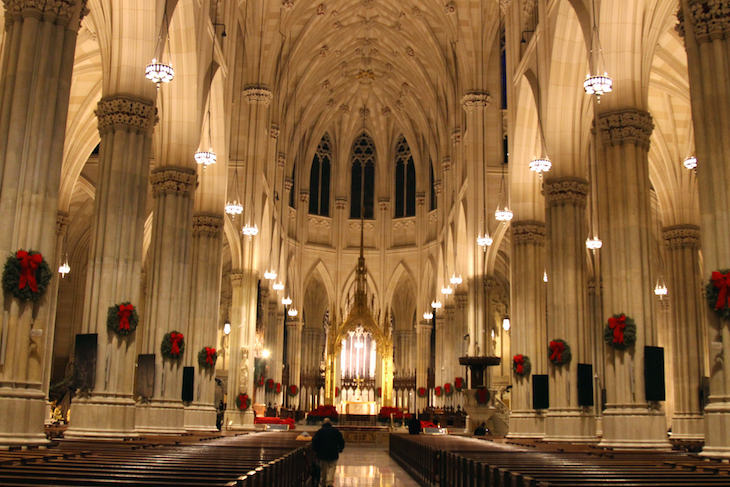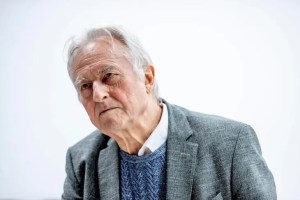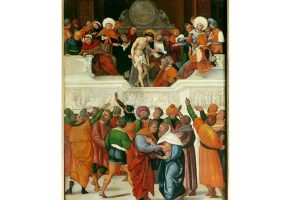A couple of years ago, in high summer, my wife and I attended Mass in St Patrick’s Cathedral, as we do every time we visit New York. It is, in general, a bracing experience for Catholics who have been paddling in the tepid pools of Irish Catholicism.
The celebrant, a middle-aged man with the physique and personality of a matinee idol, gave a startling sermon about the gospel of the day, Matthew 10:34, in which Jesus declares, ‘I have come to bring not peace but a sword.’ In his homily, the priest tore into sentimental notions of Christianity and the corruptions of concepts such as compassion and mercy. He spoke of the ‘tough love’ of Jesus and pointed out that, in the story of the Prodigal Son, although the wayward son is forgiven, his father was not saying that the he should become the ‘equal’ of the faithful one. Sure, the priest told us, mercy can sometimes seem unjust, but charity sometimes carries a big stick.
I could not be certain, but something in his train of thought suggested an implicit criticism of the Pope. For the most part, priests I encounter in the United States seem nowadays to be robust, clearheaded, gently forthright. They are also, of course, what journalists call ‘conservative’, but when you strip away the ideology and agendas behind such appellations, what you find is someone pledged to upholding the understandings he was ordained into. ‘Conservative Catholicism’ is a tautology: to posit its existence is to suggest another kind – ‘progressive Catholicism’, an oxymoron. Catholicism proffers to the world at any moment the truths it has harvested through the centuries, urging attention towards ancient understandings and complex, consequence-aware views of human nature.
In his 1997 book American Catholic, Charles R. Morris describes the building of St Patrick’s with the pennies of working Irish Catholics (there was a paucity of rich sponsors) who had come to America in the wake of the mid-19th century Irish famines. This great temple of the New World was the brainchild of Irish-born Archbishop John Hughes, who had initially been denied access to the seminary as a student because he lacked education, but he took work there as a gardener until a place was offered to him. When Hughes laid the cornerstone of the cathedral in 1858, a crowd of more than 100,000 people, mostly Irish, gathered to watch.
The Irish were neither ‘conservative’ nor ‘traditional’ Catholics in the usual sense, but simply Irish Catholics of their time, which is to say front-loaded with the idea of religion as a means of ordering moral behavior, with the Church providing leadership, education and guidance. This idea was accompanied by a clear and profound faith, by which the migrants attributed their very survival to the grace that had sustained their fathers and mothers also, through centuries of trial.
In response to repetitive calamity, a new kind of Catholicism had been spawned in Ireland – highly orthodox, even militant, moralistic, bureaucratic and defining itself mostly by virtue of its differentiation from English Protestantism. Exported to America by mass emigration of the Irish poor, it established deep roots in what had been a rather tepid melting pot of diverse Catholic nationalities, mainly Germans and Italians. The Irish moved in and took over, having the advantage of speaking English, and a particular talent for building. The resulting edifices – not just churches, but also hospitals, schools, monasteries, seminaries, retirement homes, retreat centers and communications media – became a counter-culture within America under the leadership of men like Archbishop Hughes, Dennis Cardinal Dougherty of Philadelphia and Bishop John Ireland, the Midwestern priest whose philosophy combined Catholicism with capitalism and religious freedom with social egalitarianism. Yet the church was avowedly anti-assimilationist – probably the chief reason for its growth as a robust counter-culture.
By the end of the 19th century, Catholicism had become the single largest American religious denomination, creating the semblance of unity between Catholicism and American values, yet remaining apart. The emerging, post-Civil War church was to bear an unmistakably Irish stamp: old school, inward-looking yet deeply embedded in the broader cultural and political arenas. ‘God bless the two greatest organisations in the world, the Catholic Church and Tammany Hall,’ goes the joke about the Irishman proposing a toast to his drinking companion. ‘What’s the second one?’ his mate fires back.
At its cultural zenith during the 1940s and 1950s – lionized in movies like Boys’ Town and The Song of Bernadette – this Catholicism became a highly-politicized cocoon protecting its membership against the radical individualism, assimilationism, freethinking and experimentalism that defined American culture more generally, while also harmonizing with the patriotic, pro-capital and anti-Communist sentiments of the time. This model peaked between World War One and the explosion of youth-fixated freedom-seeking in the 1960s, accompanied by the shock of Vatican II.
The sign that the Irish model of Catholicism had lost the culture war was when JFK, its most favored son, ascended to the highest American office. The church had in effect put itself out of business by educating its young into the American mainstream. The rejection of Humanae Vitae by the bulk of the American laity, followed hard by the clerical abuse scandals, rattled the church to its foundations. Irish-American Catholics had begun looking to the broader culture of permissiveness, individualism and relativism rather than to the rigorist certainties that had seen their antecedents through their darkest hours.
The threat to Christianity represented more generally by the worldliness inadequately called liberalism is an American export. Since the 1960s, the church in America has retreated from the public square, and this tendency has been exported also. When its hierarchy speaks now about matters regarded as elements of the Christian agenda, it does so in careful terms, wrapping its analysis in humanitarian, secular or civic values, and apparently accepting the dominion of Caesar in every space and building not crowned by a spire.
Ireland came late to the secularization process, which started there in the late 1970s and spread in the manner of dry rot, unobserved and undiagnosed. Hardly anyone was prepared for the culmination: the scenes in the yard of Dublin Castle last May 26, when thousands of young people, mainly female, wept and danced and sang at the news that they now had the right to annihilate their own offspring without travelling to perfidious Albion. Such events have been hailed globally as famous victories over the Irish church, but since the bishops had lately hidden away from all these battles, such claims need to be tempered with subtlety. A more precise analysis would say that Irish culture has become both hostile and indifferent to the church’s voice, which has fallen silent in consequence.
The particular moralism associated until recently with Irish Catholicism had its roots in the post-famines reconstruction, in which the Church insinuated itself as the moral government. A hallmark of this dispensation, the joke goes, is the Irish bishop who disapproves of fornication because it may lead to dancing. In the post-famines reconstruction, the mother was elevated to effective head of the family, with the father reduced to a shadow on the margins of domestic life. The dysfunctional power-partnership of priest and Irish Mammy banished the father behind his newspaper, and a symbiosis of mother and priest came to run Irish society as, in effect, a matriarchy disguised as a patriarchy. And since the mothers got to choose the next generation of priests – and often automatically selected the most effeminate of their male brood, we ended up with lots of square pegs in round holes. From this emerged the great crises of the Irish church: predatory homosexuality becoming sexual abuse, in turn covered up by offenders protecting each other. There is every reason to believe that these tendencies were exported to America also.
In recent months, we have observed a radical pushback against this culture of cover-up, and America seems, gingerly but with growing resolve, to be again leading the way. And this, I believe, is related to what I have detected in St Patrick’s – and elsewhere in America – in recent years: a Catholicism both energising and ‘orthodox’, robust and realistic, with a freshness I have not heard in Europe. Now that the uneasy peace between church and state has broken down pretty much everywhere, it is again falling to the American church to lead the way into the next dispensation..
Another sign of new vibrancy is the growth of events like the annual Fall Conference of the Center of Ethics and Cultute at the University of Notre Dame, otherwise the ‘Catholic Woodstock’, out of which emerges a consistent clarity and coherence. Likewise, the New York-based magazine First Things, speaking truth to power in a way that jells with the unspoken desires of a Western world on the brink of spiritual asphyxiation, and looking urgently for salvation, in every or any sense.
In a time of generalized hunkersliding and cowardice, the occasional hierarchical voice has emerged to speak in ways that offer hope of a different time and a clearer atmosphere. One such is Archbishop Charles J. Chaput of Philadelphia, the first Native American archbishop.
It seems that the American ‘conservative’ phenomenon I’m speaking of is about the sharpest brand of religion to be found anywhere now. The US church seems – in a small way, yes, but perhaps growingly – the kind of church Cardinal Ratzinger once spoke about when he described a church, its ascendancy ended, ‘no longer the dominant social power but enjoying ‘a fresh blossoming . . . as man’s home.’
There is bad stuff also. It may be no random fact that Archbishop Carlo Maria Vigano spent five years in the US, evenly divided between the papacies of Benedict XVI and his successor. His challenge to Pope Francis, which earned him the title The Great Accuser in the pontiff’s sermons since summer, was as though the manifesto of the many true-blue American Catholics who have looked askance in Rome’s direction since the Argentine pitched camp at Domus Sanctae Marthae in 2013.
An American friend, a sober observer of these matters, cautions that, because of the concentration of Catholicism in particular areas of the US, the intensity I’ve noted is inevitable but not likely to spread. His caution is well advised. This is, in so far as it is a revolution at all, very much an intellectual one, thus far confined to elites and small numbers. The grassroots American faithful still tend to be recent immigrants from still deeply Catholic countries – Vietnam and the Philippines, for example – who are regular mass-goers and also firm holdouts on things like abortion and gay marriage. Since a disproportionate number of seminarians in the US come from these communities also, there is a strong possibility that the immediate future of the church may be ostensibly healthy but shrinking within the overall picture. And, as one priest I questioned about this put it: ‘Sadly, the children of these immigrants who enter the universities and seminaries tend to get chewed up in the wood-chipper of liberalism and iPhone sexual anarchy and are spat out spiritually indistinguishable from fourth generation suburbanites. In the main, only those whom penury rescues from assimilation manage to hold on to Catholic doctrine and morals.’
Perhaps history has led us to look at things the wrong way around. As we have seen, the history of American Catholicism led it for a time to become immersed in party politics from a ‘right-wing’ direction. Perhaps the pressure cooker of social alienation in these fractured times is causing people with such political perspectives to seek out and re-immerse themselves in the fundamentals of their religion-of-origin, as a source of symbols, reason and a justificatory badge of identity. There are signs of such a trend already in Europe, with the popularity of Viktor Orbán in Hungary, Jacob Rees-Mogg in the UK and the signaled return of Marion Maréchal-Le Pen, who may after all become a major player in France. In other words, what was before a reaching-out from big-R Religion to small-p politics is now recurring as a reaching-back. Rich in ideas, expert in humanity and its mechanisms, Catholicism is well-placed to become the primary destination-of-choice for such searching, with America as, again, the glasshouse. You might call it a return to civilizationalism.
And maybe this is why Steve Bannon is currently lost in Europe?


















